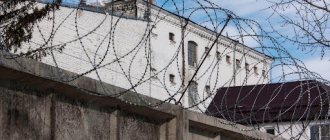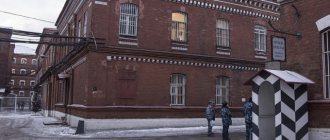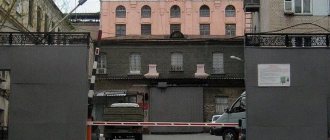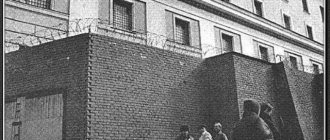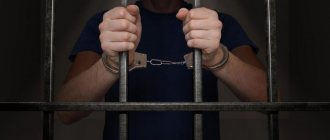Author: Beaver
04 April 2015 23:38
Tags: USSR Vladimir Central History facts
1932
10
1
Glorified by chanson star Mikhail Krug, the Vladimir Central (in the local penitentiary system it is briefly called T-2) is the closest prison to Nizhny, and there are eight of them in Russia. In the Nizhny Novgorod region there are no institutions of this type for especially dangerous criminals. Meanwhile, our fellow villains have every chance of getting here. It is symbolic that the central is located in the center of Vladimir, on Bolshaya Nizhegorodskaya Street, the once famous Vladimirka, along which murderers and “politicals” walked in stages from Moscow to Siberia for hard labor, jingling their shackles. Read more in Olga Makarova’s article “Nizhny Novgorod News”
0
See all photos in the gallery
Evil is immeasurable
0
The blocks and pads that prevented the prisoner from even thinking about escaping have long since taken their place in the museum, and in their place came video recorders and other electronic devices in these old walls. By the way, they claim that for more than two centuries of its existence there has not been a single successful attempt to escape from the prison. The fact that the supervision of convicts here is stricter than in any Nizhny Novgorod maximum security colony, the NN correspondent saw with her own eyes.
The precautions here are the strictest. For example, guests are strictly prohibited from taking photographs. The only exception is the museum exhibition space. Everyone entering the central territory, be it an employee or a visitor, is thoroughly checked with metal detectors. First with a frame, and then meticulously examined with a hand finder. And they will definitely record in the journal, for example, that the “ringing” is a belt buckle or a shoe fastener. Central is the abode of murderers, responsible for dozens of ruined souls, and serial maniacs. The precautions here are the strictest. For example, guests are strictly prohibited from taking photographs. The only exception is the museum exhibition premises. Everyone entering the central territory, be it an employee or a visitor, is thoroughly checked with metal detectors. First with a frame, and then meticulously examined with a hand finder. And they will definitely record in the journal, for example, that the “ringing” is a belt buckle or a shoe fastener. Central is the abode of murderers, responsible for dozens of ruined souls, and serial maniacs. Every second person is a rapist, every third person is a drug dealer who has pushed thousands of addicts to the abyss. The central staff protects us from 124 such unique people, demanding that they comply with the strict prison regime. In addition, people under investigation who are not placed in the local pre-trial detention center are now being placed in the famous dungeons. In total, there are currently 273 inmates in the Vladimir Central. Mostly, convicts from the Vladimir region while away their endlessly long sentences here; people from other regions are rarely registered here, but there have been no residents of Nizhny Novgorod for a long time and now there are none. Scumbags (this epithet is very suitable for the local contingent) are different here. There are so-called “lifers”. Currently there are two of them. However, this does not mean that they will spend their entire lives in the central prison - the first fifteen years at most. Then they will receive a legal relief - transfer for the remainder of their sentence (that is, until the end of their lives) to a special colony. The rest also sit for a long time - 25 or 20 years. Those whom the court appointed as a place of imprisonment in a colony also end up in the central prison, but there they constantly violated the regime, infecting others with their “houndness.” In the central area they will be well isolated. The most dangerous villains, that is, those who have nothing to lose, are placed in a special unit under extremely strict control. Here, any opening of the cell must take place in the presence of the assistant director of the prison on duty and a dog handler with a dog. They escort dangerous criminals through the corridors under heavy guard.
0
Given such security measures, I was surprised by a group in black overalls hanging out in a small enclosure near the catering unit. It turned out that this was a business unit. The selection criteria for it have recently been strengthened; people who have been jailed for drugs are no longer accepted here. Those convicted of crimes of moderate gravity end up in the household services. The “fighters” of the economic detachment do not roam freely around the territory, as, for example, in the Nizhny Novgorod pre-trial detention center. They work in a fenced area under the supervision of a special inspector. By the way, we can safely call Central a brutal prison, since women and minors are not kept here. Only men can endure the conditions. I am glad that at least this is here, but there is However, the employees of the central honor the parting words that the founder of the central, Catherine II, gave to their distant predecessors: “... treat the prison people humanely, but at the same time have a strong, unrelenting watch over them at all times, so that and no harm was done to anyone.” The first impression when we pass the checkpoint is discouraging - the smell of hot fresh bread. Like in a decent city bakery!
0
“We have our own bakery, and a contingent of the economic detachment is involved in auxiliary work,” explains Deputy Head of T-2 “Vladimirsky Central”, Lieutenant Colonel of the Internal Service Ilya Nozhov. — We provide baked goods not only for ourselves, but also for other institutions of the Federal Penitentiary Service in Vladimir. Finally we take a step into the prison yard surrounded by the famous pink and red brick buildings. You latently expect gloomy silence, imagining prisoners languishing behind barred windows. But no. Music flows through the yard: “I swear that I will become cleaner and kinder...” The words of the piercing children’s song “The beautiful is far away, don’t be cruel to me” are perceived, on the one hand, as mockery, on the other, as the leitmotif of the dreams of any local resident. Yes, freedom in all its beautiful guise is indeed very far away for them. But they all hope that the term can be reduced and are filing appeals. And sometimes not without meaning. Convict R., whom the court charged with 16 counts of murder, initially received a life sentence. But over time, he achieved a review of the case, and in the end he was given a “twenty”. It is curious that, having received a life sentence, the prisoner hurried to get himself a corresponding tattoo - a grill on his entire face. With the change of sentence, the tattoo began to look ridiculous. So, the regime does not prohibit turning on the radio. And now from the speakers Vysotsky is singing a song about a friend. But the criminal chanson is not recommended for listening here.
0
I continue to be surprised. I find out that long-term prisoners and lifers can watch TV in their cells. And conditions continue to improve year after year. One building has already been reconstructed in accordance with the federal program, another is next. Of course, it is difficult to swing in a building of old architecture. The width of the corridors here is not the same as in the new Nizhny Novgorod pre-trial detention center-2. But the cells are clean, light and spacious. The scourge of pre-revolutionary prisons—fungus—has been eliminated. “Where there used to be ten people, there are now four.” There are 4.5 square meters per convict,” says Ilya Alexandrovich. - Now there are about three hundred people in prison, and before it reached 1080. For comparison: in the old Nizhny Novgorod pre-trial detention center on Gagarin Avenue they cannot yet achieve even the legal 4 meters. A distinctive feature of the center is that the inmates rarely step on the ground. Only upon arrival at the prison does the convict enter the collection department. Then he is escorted to the security building through passages and air galleries that connect all the buildings of the central building. These galleries are also used as an exercise yard. Walks are daily. Another difference between the prison and other institutions is the exercise yards in the form of wells with an open sky in a checkered pattern. Recently, places for walking on the roof have appeared. However, this is already practiced in Nizhny Novgorod pre-trial detention center-2. Inmates are taken out for walks cell by cell. There is basic sports equipment here, you can do pull-ups on the uneven bars and exercise your abs. Convicts actively take advantage of this. Another difference from the colony. Here prisoners are not led into the dining room in formation. Dishes from the catering department are carried to the cells. Well, nutritional standards in the penal system are the same for all regions.
0
“Of course, the prison regime affects people,” the deputy head of the central continues. - No, they don’t become withdrawn. There are very sociable convicts. They realized their fate, a long time. Many hope that within 25 years their petition to reduce it will be granted. There are no obvious violators here. Many come to faith. There are no people who need serious psychological help. But there are those who can only be helped by a psychiatrist. Actually, this is logical; a person who has ruined many lives can hardly be called healthy from the point of view of psychiatry. It is difficult to comply with the legal requirement to keep convicts convicted of crimes of the same gravity in a cell. It happens that cellmates do not match in temperament, and they just can’t agree with each other. But sometimes, in order to resolve the conflict, one conversation with a psychologist or an employee of the educational department is enough. They are trying to rotate. That is, moving people from cell to cell so that they do not spend the entire long period of time in one company.
"Vladimir Central" today
The Vladimir Central prison continues to operate to this day. Particularly dangerous criminals serve their sentences there.
Today “Vladimir Central” bears the official name of FKU T-2 of the Federal Penitentiary Service of Russia for the Vladimir Region.
According to the latest data, the prison contains about 1 thousand convicts out of 1,221 people, the maximum allowed by established standards. Among them, only 15% of those convicted are serving sentences under a court sentence.
The remaining category of prisoners are malicious violators of the order of serving sentences in correctional institutions. In addition, the prison has a special block for those who received a life sentence.
Due to the fact that repeat offenders are kept in prison, criminal concepts are clearly manifested in it, which are sacredly respected by all participants. In the Vladimir Central, various attempts at riots, hunger strikes and other provocations of convicts are not uncommon.
The regime of detention in the Vladimir Central
In 2022, prison No. 2 in Vladimir is a complex of 4 buildings that house criminals who have committed serious or especially serious criminal acts.
In each prison building there are special rooms:
- In the first building there is a sector for life prisoners;
- In the second building there is a treatment block;
- In the third building there are cells for convicts;
- In the fourth building there is a pre-trial detention center and a reception department.
Thus, it turns out that a larger number of convicts are kept in the third building . There are cells designed for 2-12 people, measuring 4 by 6 or 6 by 6 meters.
Today, the prison regime has improved significantly compared to Soviet times. Ventilation appeared in the cells, their walls were painted in light colors. Each cell has a TV, refrigerator and radio.
In 1995, the St. Nicholas Church was opened in one of the prison cells. Convicts have the right to visit him. In addition, they can order books from the library, discuss their lives with a psychologist, and visit the computer room.
The library, by the way, has about 25 thousand volumes, where everyone can find literature that suits their interests. A dentist, a TB specialist and a venereologist are constantly working in the treatment block; there is a special department for HIV-infected prisoners.
All convicts, as it should be in any prison, are busy most of the time with work. The central has its own production site, where prisoners create mattresses, workwear and sports equipment. The prison bakery supplies all correctional institutions in the region with products.
North wind
“By the way, we don’t specifically play the song “Vladimir Central” on the radio here,” my interlocutor surprises me. There are many versions of creating a song. At the central office they told their story. In the nineties, Sasha Severov, a friend of Mikhail Krug, sat here. The singer came to him on a date. So the song was dedicated to him. True, initially the text contained the words “Vladimir Central, Sasha Severov, on the way from Tver...”. But a friend asked Krug to remove his name, and as a result, “the north wind” appeared.
0
In 2001, Mikhail Krug, having arrived for a concert with his group in Vladimir, visited the central one. He held a meeting with convicts from the household services. This was the singer's second visit here. The chansonnier looked original again. If the first time he came to prison in slippers, then the second time he wore an Uzbek skullcap (the photo hangs in the local museum). — Personally, I don’t like chanson. I didn’t like it from my youth, and it never stuck after many years of working in this system,” says Ilya Aleksandrovich. - Yes, we have words from feni appearing in our vocabulary. I had an interesting conversation last week with one of the convicts, an old-timer. He stated that he could not get used to the overly intelligent attitude towards himself on the part of his employees. They say that before there was only swearing, but now it’s “please stand up.” Well, times are changing. The requirements for FSIN employees are now high. By the way, it also happens that graduates of a specialized university, entering the central university for the first time, experience fear and wonder whether they have chosen the right profession. Work here is not easy. Let's say, now in the central riots are prevented by the efforts of the operational staff in the very bud. But there are individual outbursts of disobedience. Thus, on January 22, 2013, convict G., while in a punishment cell where he was placed for violating the detention regime, deliberately damaged the heating and water supply system. The detective of the operational department demanded that it be stopped. Without reacting, the prisoner struck the officer several times in the face and body, causing bodily harm. A criminal case was initiated under the article “Disorganization of the activities of an institution.” The court added three years for “plumbing.” Some inmates defiantly violate internal regulations. And in small things. For example, they don’t make the bed. So the punishment cell here is not idle. Attempts to escape are stopped. Mainly the housekeeping staff is plotting to escape from the central office. The most “successful” attempt looked like this. The convict went out to clean the area, jumped over the fence and... ended up on the territory of the legal institute adjacent to the central building. Law cadets accepted the fugitive under their white hands and handed him back.
Meat is not only for major holidays
Prisoners, and especially sick ones, were well kept in the Vladimir Central. They just preferred not to talk about it. Such secrecy was justified. If prisoners in other prisons heard about the “sweet life” in the central prison, they would certainly want it in their own. And this could not be allowed. So they hid the diet of prisoners of the Vladimir Central as a great secret.
And there was something to hide. The Vladimir transit prison had its own vegetable garden. Prisoners were regularly given fresh vegetables and meat. The patients received special nutrition. Every day they were given veal dishes for lunch, and meat broth and cutlets for dinner. The prisoners were not deprived of sweets either. They were given jelly every day, and sometimes sweet pastries.
There is even a photograph of Mikhail Frunze sitting in the Vladimirka. In it he looks very healthy and happy with life. By the way, it was Frunze who almost escaped from the Vladimir Central Prison. He failed to escape from the prison itself, but he escaped from the local courthouse. And, by the way, he was not the only known secret prisoner of the central.
Left with that girl...
0
Ultimately, everyone here becomes believers and really wants to work. They acquire a hobby. Some solve crossword puzzles, others begin to sculpt figures, draw, and write poetry. Interesting fact. 80 percent of convicts in the central are employed. The administrations of the Nizhny Novgorod colonies cannot even dream about this even in their sweetest dreams. But the organization of production here is specific - to match the contingent.
Thus, all cell inmates are taken to the workshop cell for their shift under the strictest escort. For prevention purposes, it is planned that cellmates live and work together. Communication with other inhabitants of the prison is completely excluded. After all, the central prison contains malicious violators, including those who incited riots in the colonies. Authorities. That’s why they are here in strict isolation, so that they can’t organize anything bad. They mainly produce sports equipment. Soccer and volleyballs, sports equipment such as a jumping goat. — There are sales, but not as much as we would like, since Chinese goods are several times cheaper than ours. Although balls with the symbols of the Vladimir Central are selling well, says Ilya Nozhov. Electrical distribution boxes are also assembled here and motor windings are made for the Vladimir Electric Motor Plant. The only people not working are pensioners, disabled people and those who would like to work, but don’t need to. These are lifers and thieves in law. The latter will not work on their own, and they should not be allowed into the general team. One of the lifers, however, was brought materials for collecting boxes directly to his cell. The salary of hard workers in uniforms reaches 3 - 4 thousand. Residents have no restrictions on correspondence. Write as much as you want. But a significant number of convicts do not want to. It happens that relatives call the prison authorities and are worried. Sometimes educators have to persuade prisoners to write a letter to their relatives when they are released. “If a person initially communicates with his family, starting from the pre-trial detention center, then throughout the entire period the connection is not interrupted,” explains Ilya Aleksandrovich. — They draw cards for children and send crafts to their wives. But it also happens. A person receiving a long sentence believes that there is no point in communicating. True, psychologists still encourage convicts to maintain contact with loved ones. Children are often brought on dates. Of course, separation from a child is especially difficult.
0
The prisoner Arthur was imprisoned for triple murder. He considered himself innocent and said that everything happened because he was drunk. In the wild, he had a little daughter left without a mother. A distant relative took her into custody. Arthur loved the girl very much. She was everything to him. He was ready to work for days on end for the lawyer’s fee, if only he could achieve a reduction in the sentence. Then he would have seen his daughter earlier. The caretaker constantly tried to call her, but her relatives did not allow the girl to communicate with her father. But one day, before her birthday, Arthur managed to talk to his daughter on the phone. She asked for gold earrings as a gift. So he worked hard for three. ...And rays of warmth - Cultural events in prison among the contingent are prohibited, - explains Ilya Alexandrovich. “This is another significant difference from the colony. A prison is a place where a convicted person is kept in a cell. And the housekeeping staff has no time for football and concerts; they already have a lot to do. They organize open days for relatives. But now there is no information vacuum, as before, everyone has the opportunity to watch TV. We have a legal center, and a convicted person can always find out on the Internet, for example, changes in the Criminal Code under his article. True, the computer mouse will be in the hands of the employee. Those who are not used to reading in the wild acquire this habit here. Librarian Irina Zakurdaeva has been working at the central for four decades. A real ascetic. She has a talent for obtaining books for the prison library collection. The Book Guardian actively works with editorial offices, city reading rooms, and philanthropists. She calls her readers, prisoners, kids.
- We have all! - says Irina Vladislavovna. — And kids, especially young ones, now prefer fantasy. Dostoevsky, Karl Marx's Capital, and legal literature are still in demand. Those who receive secondary education from us often order English textbooks. And then they study it on their own. Of the poems they prefer Yesenin. Many people subscribe to newspapers. Magazines about hunting and fishing, as well as about interior design and home renovation, are popular. She says she doesn't have favorites. Welcomes everyone who wants to borrow a book. - They read very quickly. I just gave out the volume, and he’s already returning it back,” says Irina Vladislavovna. — By the way, we don’t issue detectives. We don’t keep The Count of Monte Cristo. “We cannot study remotely at a university,” explains Ilya Nozhov. “However, our contingent does not have such a desire.” Here they sit either with two higher educations or with two classes. And if the resident is not at all attracted to fiction, then the Bible becomes the reference book for such people. In the central building there is a prayer room, converted from an ordinary cell. It can be easily recognized by the domes on the roof and the bells behind the window bars. The sins of the local inhabitants are grave. Therefore, in the central building, despite all the renovations, cleanliness and order, the atmosphere is uncomfortable, depressing, and you want to leave these walls as soon as possible.
0
The leader's son and ministers behind bars
For a long time it was hidden that Vasily Stalin, Stalin’s son, was sitting in the central prison. He remembered the Vladimir Central for a long time. Vasily's last name was changed, and he became not Stalin, but Vasilyev. And his conditions of detention were better than those of the others. There was a radio in Vasily’s cell, and he was also allowed visits. The same cannot be said about other “numbered” prisoners.
Vasily Stalin's name was changed in the dossier. But they didn’t even do this for other famous prisoners. No one knew the names and surnames of the “numbered” prisoners except the prison director. For a long time they remained a mystery. But years later, it was possible to figure out that famous people were hiding behind the faceless numbers. For example, the highest ranks of the German and Japanese armies who were captured. Among the secret prisoners were ministers of some Baltic republics. Famous thieves in law also sat in Vladimirka. For example, the last correct thief in law Vladimir Babushkin.
Famous inmates
On August 15, the Vladimir Central turns 231 years old. Initially founded by decree of Catherine II, a workhouse (for those guilty of minor crimes) over time turned into a prison for especially dangerous criminals. It is called central because in the old days there was a central transit prison here. Many famous personalities visited the Vladimir Central as prisoners: - Vasily Vitalievich Shulgin, a major political statesman of pre-revolutionary Russia. On March 2, 1917, a deputy of three State Dumas accepted the abdication of Emperor Nicholas II from the throne. Creator and inspirer of the White Guard movement. On December 24, 1944, in Yugoslavia, in the city of Sremski Karlovtsi, he was arrested by SMERSH counterintelligence. — Writer, philosopher, poet Daniil Andreev served 10 years in Vladimir prison. He was arrested in 1948. Here he wrote his famous work “Rose of the World”. — From 1945 to 1955, officers and generals of the fascist army served their sentences in the Vladimir prison. Among them are Angelis Maximilian, commander of the 2nd Panzer Army, von Bredow Hans, commander of the Baltic coast, Weidling Helmut, commandant of Berlin, Hammerschmidt Fritz, chief of staff of the Berlin police, Guse Gunther, admiral of the German Navy, Müller Siegfried, staff officer, brother of Müller , chief of the Gestapo. And also Japanese prisoners of war. Among the “numbered” prisoners, we can list the following: - an outstanding figure of Tajik culture, Said Rizo Alizade - the first translator into Uzbek and Tajik languages of the works of Pushkin, Tolstoy, Gogol and other Russian classics. Descendant of the prophet Muhammad. He was arrested on a false denunciation as a foreign spy; - son of Generalissimo Vasily Stalin. He was released several times and returned again, then exiled to Kazan, where he died in 1962; — in 1950, the popularly beloved singer Lidiya Ruslanova was placed here for her participation in an anti-Soviet group. Actress Zoya Fedorova, arrested in December 1948 and sentenced to 25 years in prison for terrorism, sat in the same cell with her.
Vladimir Central Prison: history
The work of the prison dates back to the 18th century. By decree of Empress Catherine II, this correctional institution was built in 1783.
At first it was a workers' house, built by the architect Nikolai von Berk, which later served as the beginning of the emergence of the Vladimir Central.
Many are interested in the question of what “Vladimirsky” means means the central location of the prison, which was the main correctional institution in this territory. The Vladimir name of the prison refers to its location.
Initially, the Vladimir Central served as a refuge for political prisoners.
The prison was included in the system of “special prisons and camps”, which was created on the basis of the resolution of the Council of Ministers of the USSR in 1948 “On the organization of camps of the Ministry of Internal Affairs with a strict regime for the detention of especially dangerous state criminals.”
At this time, the following categories of criminals were kept in the prison:
- Saboteurs;
- Spies;
- Terrorists;
- Social Revolutionaries;
- Anarchists;
- Mensheviks;
- Nationalists, etc.
Everyone who posed a danger at that time to the current Soviet government of the Bolsheviks was exiled to the Vladimir Central.
The official name of the prison, which was preserved according to archival documents and records, was “Vladimir Special Purpose Prison of the USSR Ministry of State Security.” At that time, convicts were even given special marks “KAT” or “CAT”, “THIEF”.
Where is Vladimir Central located? The prison is located in the city of Vladimir on Bolshaya Nizhegorodskaya street, house 67A.
Museum in prison
In 1996, a museum was opened on the territory of the now operating Vladimir Central prison. The author of the entire exhibition presented in the museum is V.E. Gurinovich, materials provided by the Vladimir-Suzdal Museum.
When visiting the museum, you can see the following exhibits:
- Photographs and paintings. Basically all the photographs describe the very good life of prisoners in prison. Here they are captured in the recreation room, at the computers at an open day with relatives. The museum even contains a photograph of Mikhail Krug himself, who came to the Vladimir Central. The paintings were painted by prisoners. Of course, those exhibited in the museum are those that are distinguished by their special skill and drawing technique. Many of the convicts draw very well.
- Typical prison cell. Here you can see the cell door, the prisoner's bed, kitchen utensils and the mannequin of the convict himself in prison clothes.
- Historical documents. In the museum you can familiarize yourself with the first rules for the organization of a prison, which were adopted under Peter the Great, and the charter on prisons of Catherine the First. In addition, the museum contains a large number of historical photographs of the prison and its prisoners.
- Paper models of a prison in different historical eras.
- Pads and shackles.
- Information about the heads and employees of the prison with photographs.
- Mannequin of a sentry in uniform.
- Forgeries created by prisoners.
All the time, museum visitors are accompanied by a guide who tells in detail about each exhibit and the history of the prison and the museum. You can get all the information about the work of the museum through the prison website.

